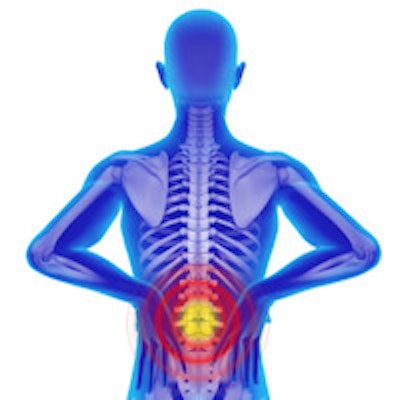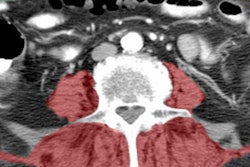
Older adults who have spine imaging within six weeks after an initial visit for care for lower back pain were no better off the following year than similar patients who did not undergo early imaging, according to a study published in the March 17 issue of the Journal of the American Medical Association.
Researchers from the University of Washington said the lack of clinical benefit for these patients is in contrast to the increased use and cost of radiography, CT, and MRI for early imaging.
The study estimated that total payments (payor and patient contributions) after the first year were $1,380 higher for patients who received early radiographs and $1,430 higher for those who had early MRI or CT scans, compared with back pain patents who did not receive early imaging (JAMA, March 17, 2015, Vol. 313:11, pp. 1143-1153).
"It is very clear from our data that imaging patients earlier is not going to lead to better outcomes on average across the cohort ... unless there is that red flag that indicates they should be imaged early," lead author Dr. Jeffrey Jarvik, a professor of radiology, neurological surgery, and health services, told AuntMinnie.com. "Those red flags are a history of cancer, if they have had serious trauma, or a history of osteoporosis and nonserious trauma. But in the absence of those [red flags], the routine use of imaging does not seem to bring a benefit."
First-of-its-kind study
Jarvik and colleagues used data from the Back Pain Outcomes Using Longitudinal Data (BOLD) project. The prospective cohort consisted of 5,239 patients who were 65 years or older and sought primary or urgent care for low back pain between 2011 and 2013. Subjects had not sought care for low back pain within the previous six months.
"This is really the first large-scale study that looks at older adults with back pain, rather than mix them with younger adults," Jarvik said. "We were very focused on this question: Does this early imaging in older adults improve their outcomes or not?"
 Dr. Jeffrey Jarvik from the University of Washington.
Dr. Jeffrey Jarvik from the University of Washington.Patient data came from three health maintenance organizations (HMOs) -- Harvard Vanguard, Henry Ford Health System, and Kaiser Permanente Northern California -- that are part of the HMO Research Network. "We did this intentionally, so we could be confident that we [were] tracking longitudinal utilization of care without worrying that we were missing much data," Jarvik added.
The researchers had access to subjects' complete medical and administrative records, as well as patient-reported outcomes from their initial care visit and at three, six, and 12 months. Jarvik and colleagues measured the severity of back pain, its effect on daily activities, and resource utilization associated with the episode of care.
The researchers also matched early imaging subjects with a control group based on similar demographic and clinical characteristics, including diagnosis, pain severity, pain duration, functional status, and prior resource use. The control group consisted of BOLD patients who did not receive early imaging within six weeks of their primary care visit for back pain.
Of the initial 5,239 participants, data were unavailable for 84 patients, and 228 patients withdrew before completing one year of follow-up. Also excluded were 34 patients with a cancer diagnosis in the year before the initial visit for care, 34 people who died, five people who had lumbar spine surgery in the prior year, and one patient who had a bone scan and no other imaging within six weeks after the initial visit. This left 4,853 subjects.
Among the 1,264 patients (26%) who received early radiographs, 1,174 were matched with controls. Meanwhile, of the 366 patients (7%) who received early MRI or CT scans, 349 were matched with controls.
Primary outcomes were based in part on the Roland-Morris Disability Questionnaire, which measures physical limitations due to back pain. The scale ranges from 0 for no pain-related limitations to 24 for maximum pain-related limitations. The researchers also administered six secondary outcome measures at baseline and at three, six, and 12 months, which included patients rating their pain from 0 (no pain) to 10 (worst pain imaginable).
No clinical difference
In the analysis of data and patient-reported outcomes, Jarvik and colleagues found no statistically significant or clinically meaningful difference in primary outcomes, in scores from the Roland-Morris Disability Questionnaire, or between the early and nonearly imaging groups at any time point.
Patients who received early radiography posted lower numerical leg pain scores at three, six, and 12 months than individuals who did not receive early imaging. However, while the differences were statistically significant, "these differences were clinically unimportant," the authors concluded.
Patients with early MRI or CT scans had significantly lower six-month leg pain rating scores than the control group, but again the researchers found no clinically meaningful difference.
As for utilization, Jarvik and colleagues found a marked difference in one-year resource use and costs. Mean total relative value units (RVUs) were approximately 40% higher in the early radiograph group and 50% higher in the early MRI/CT cohort, compared with the controls. Overall costs were also 27% greater for the early radiograph group and 30% higher for the MRI/CT patients, compared with the controls.
Spine-related expenditures (as a percentage of overall expenditures) were 17% in the early radiograph group, compared with 7% for the control group, and 29% for the early MRI/CT group, compared with 11% for the controls.
Surprising result
Jarvik said the most surprising result was "the magnitude of the resource difference between those who got early imaging and those who did not."
"Overall, resource use was 50% higher in the group that got early imaging, compared to those who did not, and spine-specific resource use was three times higher in the early imaging group," he said.
As expected, radiography was used more often than MRI and CT in early imaging, and in terms of cost differences, MRI was slightly more expensive for patients undergoing early imaging than radiography.
"But the bottom-line message is still the same," Jarvik said. "Early imaging, regardless of the imaging modality, does not convey a benefit with respect to patient outcome, but it costs more."
He emphasized that the findings do not mean that nothing should be done for this patient population. Depending on a patient's condition, there are different approaches and interventions that could help relieve their pain.
"Early physical therapy may be something that is worthwhile," Jarvik said. "That is something we are investigating within this cohort. Over-the-counter medications also may have a role as well."
The researchers are continuing to follow this patient group to see if any individuals eventually have surgery to alleviate their lower back pain. Future studies may also explore other interventions, such as the early use of physical therapy or medications, and their benefits.



















